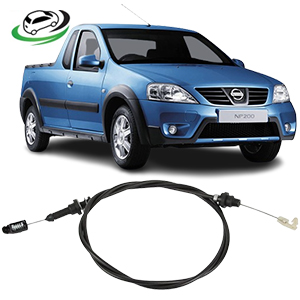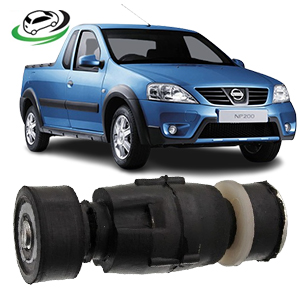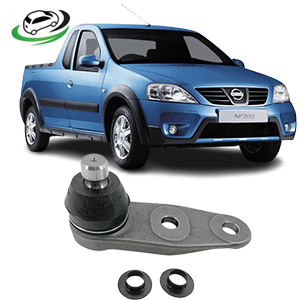-6%
Get Nissan Pick Up NP200 Lower Ball Joint Assy R/L SB-N112
The Lower Ball Joint Assembly is a critical component in a vehicle’s suspension system, allowing the wheels to move smoothly up and down while also providing the flexibility for steering. Ball joints are a type of pivot or bearing that connect the control arms of the suspension to the steering knuckles, allowing the wheels to turn and move independently while maintaining a stable connection to the rest of the vehicle. The lower ball joint is specifically located at the bottom of the suspension system, playing a key role in vehicle handling, steering, and overall ride comfort.
In this detailed 1000-word explanation, we will cover the structure, function, types, maintenance, symptoms of failure, and the importance of the lower ball joint assembly in automotive performance.
Structure of the Lower Ball Joint Assembly
The lower ball joint assembly is typically composed of several key parts:
- Ball Stud: The ball stud is a spherical or ball-shaped piece that fits into a socket. This ball is connected to the control arm and allows for movement in various directions.
- Socket Housing: This is the metal casing that holds the ball stud in place while allowing it to move. It’s typically made of steel or high-strength aluminum to ensure durability under stress.
- Rubber Boot: A flexible rubber boot is used to cover the ball stud and socket housing, keeping the internal components lubricated and protected from dirt, water, and debris. The boot helps prevent contamination, which can lead to premature wear.
- Grease Fitting (Zerk Fitting): Some ball joints come with a grease fitting that allows for the addition of lubrication during regular vehicle maintenance. Grease fittings make it possible to maintain the smooth movement of the ball stud within the socket housing.
- Mounting Plate or Control Arm Mounting Point: The lower ball joint is usually attached to the control arm via a mounting plate or directly integrated into the control arm, depending on the vehicle design. This allows it to hold the weight of the vehicle and maintain the proper suspension geometry.
Function of the Lower Ball Joint Assembly
The primary function of the lower ball joint assembly is to serve as a flexible connection point between the steering knuckle and the control arm. It allows the suspension to move vertically as the vehicle encounters bumps, dips, or uneven road surfaces while enabling the wheels to rotate horizontally for steering. In simpler terms, the lower ball joint allows the suspension to absorb impacts and keep the wheels aligned while allowing steering movements to take place smoothly.
Key functions include:
- Support for Vertical Movement: As the vehicle drives over uneven surfaces, the suspension needs to move up and down. The lower ball joint allows the control arms to pivot, letting the wheels move vertically without affecting the connection to the steering knuckle.
- Facilitation of Steering: While allowing vertical movement, the lower ball joint also lets the wheels rotate side to side for steering. The spherical shape of the ball stud enables this multi-directional movement.
- Vehicle Load Bearing: In many vehicle designs, especially those with double-wishbone or MacPherson strut suspension systems, the lower ball joint bears a significant amount of the vehicle’s weight. It must support the load of the vehicle while maintaining smooth movement.
Types of Lower Ball Joints
Ball joints can be classified based on different factors, including design and whether they are serviceable. Common types include:
- Load-Bearing Ball Joints: These are often found in the lower control arms, as they support the weight of the vehicle. They are critical for maintaining suspension alignment and handling.
- Non-Load-Bearing Ball Joints: These ball joints are typically located in the upper control arms and are mainly responsible for allowing steering movement. They do not bear as much load as the lower ball joints.
- Serviceable Ball Joints: Some ball joints come with grease fittings, allowing for regular lubrication during maintenance. These serviceable ball joints can be kept in good working order for longer periods if they are greased regularly.
- Non-Serviceable Ball Joints: Many modern vehicles use sealed ball joints, which come pre-lubricated and are not designed to be serviced. Once the grease inside the sealed joint wears out or the joint becomes worn, the entire assembly must be replaced.
Importance of Lower Ball Joint Assembly in Suspension and Handling
The lower ball joint is a critical link in the vehicle’s suspension and steering systems, affecting several key aspects of vehicle performance:
- Ride Comfort: By allowing the wheels to move up and down independently of the vehicle’s chassis, the lower ball joint helps to absorb shocks and vibrations from the road. A properly functioning ball joint ensures that the ride remains smooth and comfortable, even on rough surfaces.
- Steering Control: Because the lower ball joint allows the wheels to rotate left and right for steering, it plays a direct role in steering precision. A faulty ball joint can cause looseness or play in the steering, reducing the driver’s control over the vehicle.
- Suspension Geometry: The lower ball joint helps maintain proper suspension alignment and geometry. If the ball joint wears out, it can lead to suspension misalignment, which may cause uneven tire wear and negatively impact handling.
Symptoms of a Failing Lower Ball Joint
Like all mechanical parts, lower ball joints wear out over time due to the constant movement and stress they endure. When they begin to fail, several symptoms can arise:
- Clunking Noises: One of the most common signs of a bad ball joint is a clunking or knocking noise when driving over bumps or when turning. This noise occurs because the ball stud is moving excessively within the socket due to wear.
- Uneven Tire Wear: A worn-out lower ball joint can cause the suspension to become misaligned, resulting in uneven tire wear. This can lead to tires wearing out more quickly and unevenly, which may cause a rough ride or handling issues.
- Loose or Wandering Steering: A failing lower ball joint can cause the steering to feel loose or imprecise. The driver may notice that the vehicle wanders or pulls to one side, making it more difficult to maintain control, especially at higher speeds.
- Vibrations: Excessive play in the ball joint can lead to vibrations in the suspension, which may be felt in the steering wheel. This can make driving uncomfortable and increase wear on other suspension components.
- Steering Wheel Misalignment: A worn ball joint can cause the steering wheel to become misaligned, leading to the vehicle pulling to one side. This may require constant corrections to keep the vehicle moving straight.
Maintenance and Replacement of Lower Ball Joints
Maintaining lower ball joints is essential to the vehicle’s overall suspension health. While many modern ball joints are sealed and do not require regular maintenance, older or serviceable ball joints with grease fittings should be lubricated during routine vehicle maintenance.
Here are some maintenance tips:
- Inspect Regularly: Have your ball joints inspected regularly, especially if your vehicle is older or used in harsh driving conditions.
- Lubricate: If your ball joints are serviceable, lubricate them during every oil change or as recommended by the manufacturer. This helps to prolong their life and keep them operating smoothly.
- Replace Worn Ball Joints: If a ball joint shows signs of wear, it should be replaced immediately. Delaying replacement can lead to more severe damage to the suspension and steering systems, as well as potential safety hazards.
Conclusion
The Lower Ball Joint Assembly is a vital component of a vehicle’s suspension and steering systems. It supports the weight of the vehicle, allows for vertical and horizontal movement, and plays a crucial role in ensuring smooth handling and ride comfort. Proper maintenance and timely replacement of worn ball joints are essential for the safe and reliable operation of the vehicle. Recognizing the symptoms of a failing lower ball joint, such as clunking noises, uneven tire wear, and steering looseness, is key to preventing further damage and ensuring the vehicle remains in optimal condition.
Follow us on Facebook for more parts.



